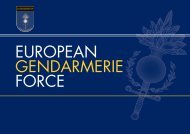Conference
science-research-bulletin-2013-conference
science-research-bulletin-2013-conference
You also want an ePaper? Increase the reach of your titles
YUMPU automatically turns print PDFs into web optimized ePapers that Google loves.
EUROPEAN POLICE SCIENCE AND RESEARCH BULLETIN<br />
SPECIAL CONFERENCE EDITION<br />
governing police cooperation has frequently<br />
been discussed (Mitsilegas, 2009, pp. 59-110;<br />
Klip, 2009; Klip & van der Wilt, 2002; Asp, 2001).<br />
Since the Treaty of Lisbon in 2007 (Treaty of<br />
Lisbon Amending the Treaty on European Union and<br />
the Treaty Establishing the European Community),<br />
these discussions have become even more vivid<br />
(Ladenburger, 2008).<br />
Although common legal frameworks can be<br />
said to exist in the EU, such as the Schengen<br />
Convention, their implementation is far from<br />
uniform (Joubert & Bevers, 1996, p. 11 [in<br />
relation to languages], pp. 15-17 [in relation to<br />
different interpretations]). EU legal frameworks<br />
provide general strategies for police cooperation,<br />
which need to be translated into national<br />
legislation and bilateral or multilateral treaties<br />
and agreements to become operational at<br />
the national level (Article 39, para 5 of the<br />
Schengen Convention). The differences in the<br />
implementation processes and in legal systems<br />
in relation to criminal law, procedure, data<br />
protection and evidence laws therefore continue<br />
to hamper cooperation (Joubert & Bevers, 1996,<br />
pp. 538-542; Interview German-French Police<br />
and Customs Cooperation Centre). It became<br />
one of the major tasks of European integration<br />
to improve cooperation by creating harmonised<br />
legal regulation and ‘compensatory’ measures<br />
with a view to common standards, practices and<br />
institutions (see, for the distinction between the<br />
three legislative dimensions, Monar, 2006).<br />
Problems in the area of information exchange<br />
have led to the recent establishment of<br />
another prominent legal framework, the Prüm<br />
Convention (Convention Between the Kingdom<br />
of Belgium, the Federal Republic of Germany,<br />
the Kingdom of Spain, the French Republic, the<br />
Grand Duchy of Luxembourg, the Kingdom of<br />
The Netherlands and the Republic of Austria on<br />
the Stepping up of Cross-border Cooperation,<br />
Particularly Combating Terrorism, Cross-border<br />
Crime and Illegal Migration), which implements<br />
a system of mutual recognition in the field<br />
of information exchange. Furthermore, the<br />
establishment of Europol in 1995 (Council Act of<br />
26 July 1995 Drawing up the Convention based<br />
on Article K.3 of the Treaty on European Union on<br />
the Establishment of a European Police Office) was<br />
intended to improve the sharing of data between<br />
the Member States’ law enforcement agencies.<br />
Europol can to a certain extent be compared to<br />
Australian federal agencies, as it provides for a<br />
law enforcement institution with overarching<br />
responsibility for national jurisdictions within the<br />
EU and because it can participate, similar to the<br />
Australian Federal Police, in Joint Investigation<br />
Teams, despite its lack of law enforcement<br />
powers.<br />
III. AUSTRALIAN POLICE<br />
COOPERATION STRATEGIES<br />
Unlike the EU with its 28 Member States, Australia<br />
is only divided into nine different criminal<br />
jurisdictions (Bronitt, 2009, pp. 2, 4). However,<br />
similar to the EU, each of these is policed by its<br />
own police force and specialised law enforcement<br />
agencies (Finnane, 1994, pp. 14-23). Problems of<br />
border crossing, information exchange and joint<br />
investigations are therefore confronted due to<br />
differences between state and territory laws in<br />
the field of substantive and procedural criminal<br />
law and data protection laws (Bronitt, 2009,<br />
pp. 2, 4). Another factor that is less frequently<br />
considered, but no less important, is the difference<br />
in organisational culture and investigative<br />
techniques of the state and territory police forces.<br />
The difficulties of cross-border enforcement in<br />
Australia are particularly apparent in relation<br />
to calls for new laws to enable cross-border<br />
investigation in the last decade. These reform<br />
proposals deal primarily with mutual recognition<br />
of law governing controlled operations, assumed<br />
identities, electronic devices and witness<br />
anonymity (Standing Committee of Attorney<br />
General and Australasian Police Ministers Council<br />
Joint Working Group on National Investigations,<br />
2003, i).<br />
While similarities between the EU and Australia<br />
are apparent in relation to the situation of policing<br />
across borders, major constitutional differences<br />
exist that need to be considered when comparing<br />
both systems. Unlike the EU, Australia is one<br />
nation, established as a constitutional democracy<br />
(Chapter I, Australian Constitution). It therefore<br />
is governed by constitutionally established<br />
federal organs of government with clear federal<br />
competences (Chapter II, Australian Constitution).<br />
However, similarities are created by the subdivision<br />
of Australia into states and territories<br />
following the former system of colonies (Parkinson,<br />
1994, p. 148). The power to enforce state and<br />
territory laws and the autonomy in making these<br />
laws stems from the Australian Constitution, which<br />
confers some degree of autonomy in relation to<br />
117





